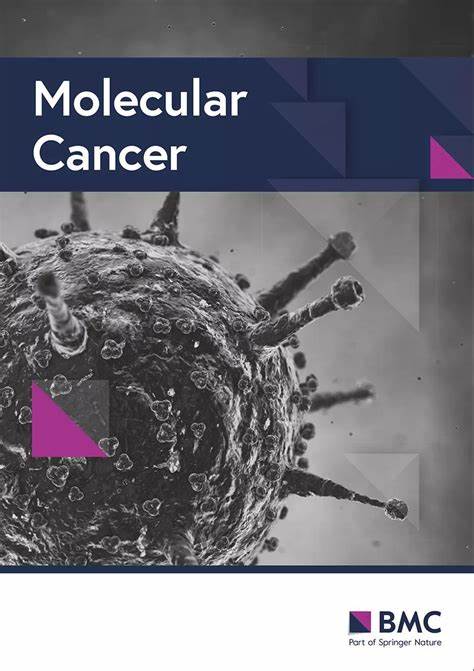CREPT is required for the metastasis of triple-negative breast cancer through a co-operational-chromatin loop-based gene regulation
IF 33.9
1区 医学
Q1 BIOCHEMISTRY & MOLECULAR BIOLOGY
引用次数: 0
Abstract
Triple-negative breast cancer (TNBC) is recognized for its aggressiveness, yet the mechanism underlying metastasis remains unclear. Here, we report that CREPT/RPRD1B, which exhibits somatic gene copy-number amplifications and elevated expression, correlates with poor patient survival and drives TNBC metastasis. We demonstrate that CREPT alters three-dimensional genome structures in topologically-associating domain (TAD) status and chromatin loops via occupying promoters and enhancers. Specifically, CREPT mediates 1082 co-operational chromatin loops configured by enhancer-promoter and promoter-termination loops, which are validated by HiChIP analyses and visualized by Tn5-FISH experiments. These loops orchestrate RNAPII loading and recycling to enhance the metastatic gene expression. Disruption of these co-operational loops using CRISPR-dCas9 suppresses TNBC metastasis in vivo. Furthermore, depletion of CREPT using an AAV-based shRNA blocks TNBC metastasis in both preventative and therapeutic mouse models. We propose that targeting CREPT to disrupt the co-operational chromatin loop structures represents a promising therapeutic strategy for metastatic TNBC. • Somatic CREPT gene copy-number amplifications with elevated expression occur in the metastatic triple-negative breast cancer (TNBC) and correlate with poor patient survival • CREPT mediates 1082 co-operational chromatin loops configured by enhancer-promoter and promoter-termination loops • CREPT-mediated co-operational chromatin loops regulate metastatic genes during the metastasis of TNBC • Depleting CREPT by adeno-associated virus (AAV) blocks TNBC metastasis in preventative and therapeutic mouse models在三阴性乳腺癌的转移过程中,蹑手蹑足是一种基于染色质环的协同基因调控所必需的
三阴性乳腺癌(TNBC)因其侵袭性而被公认,但其转移机制尚不清楚。在这里,我们报道了蹑手蹑脚/RPRD1B,它表现出体细胞基因拷贝数扩增和表达升高,与患者生存不良和驱动TNBC转移相关。我们证明,爬行改变三维基因组结构的拓扑相关域(TAD)状态和染色质环通过占领启动子和增强子。具体来说,该基因介导了1082个由增强子-启动子和启动子-终止环组成的协同染色质环,这些染色质环通过HiChIP分析和Tn5-FISH实验进行了验证。这些环协调RNAPII的装载和再循环,以增强转移基因的表达。在体内使用CRISPR-dCas9破坏这些协同循环抑制TNBC转移。此外,在预防性和治疗性小鼠模型中,使用基于aav的shRNA去除蹑细胞可以阻断TNBC转移。我们提出,靶向破坏协同染色质环结构是转移性TNBC的一种有希望的治疗策略。•在转移性三阴性乳腺癌(TNBC)中,体细胞蹑手蹑脚基因拷贝数扩增和表达升高与患者生存率低相关•蹑手蹑脚介导1082个由增强子-启动子和启动子-终止环构成的协同染色质环•蹑手蹑脚介导的协同染色质环在TNBC转移过程中调节转移基因•通过腺相关病毒(AAV)耗尽蹑手蹑脚可阻断TNBC的预防和治疗转移小鼠模型
本文章由计算机程序翻译,如有差异,请以英文原文为准。
求助全文
约1分钟内获得全文
求助全文
来源期刊

Molecular Cancer
医学-生化与分子生物学
CiteScore
54.90
自引率
2.70%
发文量
224
审稿时长
2 months
期刊介绍:
Molecular Cancer is a platform that encourages the exchange of ideas and discoveries in the field of cancer research, particularly focusing on the molecular aspects. Our goal is to facilitate discussions and provide insights into various areas of cancer and related biomedical science. We welcome articles from basic, translational, and clinical research that contribute to the advancement of understanding, prevention, diagnosis, and treatment of cancer.
The scope of topics covered in Molecular Cancer is diverse and inclusive. These include, but are not limited to, cell and tumor biology, angiogenesis, utilizing animal models, understanding metastasis, exploring cancer antigens and the immune response, investigating cellular signaling and molecular biology, examining epidemiology, genetic and molecular profiling of cancer, identifying molecular targets, studying cancer stem cells, exploring DNA damage and repair mechanisms, analyzing cell cycle regulation, investigating apoptosis, exploring molecular virology, and evaluating vaccine and antibody-based cancer therapies.
Molecular Cancer serves as an important platform for sharing exciting discoveries in cancer-related research. It offers an unparalleled opportunity to communicate information to both specialists and the general public. The online presence of Molecular Cancer enables immediate publication of accepted articles and facilitates the presentation of large datasets and supplementary information. This ensures that new research is efficiently and rapidly disseminated to the scientific community.
 求助内容:
求助内容: 应助结果提醒方式:
应助结果提醒方式:


